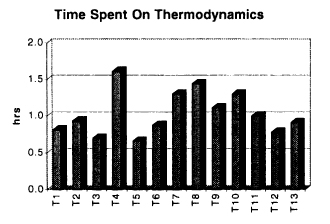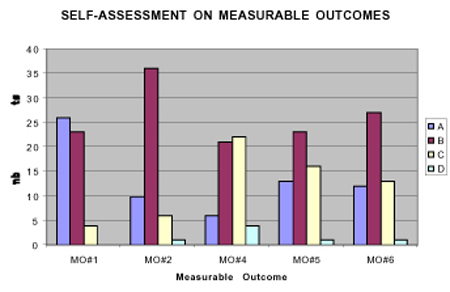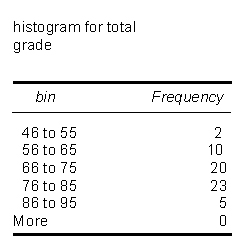Fall Term 1999, 62 students in the class, 13 lectures, plus 5 recitation sections that I taught.
I. Top-Level Learning Objective
To be able to use the First Law of Thermodynamics to estimate the potential for thermo-mechanical energy conversion in aerospace power and propulsion systems.
Measurable Outcomes (Assessment Method)
- To be able to state the First Law and to define heat, work, thermal efficiency and the difference between various forms of energy. (quiz, self-assessment)
- To be able to explain at a level understandable by a high school senior or non-technical person how various heat engines work (e.g. a refrigerator, an IC engine, a jet engine). (quiz, self-assessment)
- To be able to identify and describe energy exchange processes (in terms of various forms of energy, heat and work) in aerospace systems.
- To be able to apply the steady-flow energy equation or the First Law of Thermodynamics to a system of thermodynamic components (heaters, coolers, pumps, turbines, pistons, etc.) to estimate required balances of heat, work and energy flow. (homework, quiz, self-assessment)
- To be able to explain at a level understandable by a high school senior or non-technical person the concepts of path dependence/independence and reversibility/irreversibility of various thermodynamic processes, to represent these in terms of changes in thermodynamics state, and to cite examples of how these would impact the performance of aerospace power and propulsion systems. (homework, quiz, self-assessment)
- To be able to apply ideal cycle analysis to simple heat engine cycles to estimate thermal efficiency and work as a function of pressures and temperatures at various points in the cycle. (homework, self-assessment)
II. General Comments on the Delivery of the Course Material
This is the fourth time that I have taught the thermodynamics section of Unified. I hand out lecture notes that contain all the information I would like the students to learn. The students appreciate these notes (see student feedback data). I also require that they purchase van Wylen, Sonntag and Borgnakke which is the same book that is required in the follow-on course (16.050).
This semester I applied active learning in all of the lectures (muddiest part of the lecture cards, unannounced reading quizzes and turn-to-your-partner activities in every class). I also asked the students to self-assess their learning at the end of the module. I found that teaching the recitation sections myself (instead of relying on a TA as I have in the past), gave me much more time to cover the material in the way I want to cover it. I believe the overall product was better as a result.
The active learning questions tended to take about 10 minutes each. These are sketched into the margins of the prepared notes and written down on the hand-written lecture notes that I prepare for each class (Action: I need to organize these in a better fashion.).
III. Assessment Data
| ASSESSMENT METHOD | FORMATIVE | SUMMATIVE |
|---|---|---|
| Muddiest Part of the Lecture | X | |
| Quiz | X | |
| Homework | X | X |
| Self-assessment | X | |
| Reading Quizzes | X | X |
| CEG and SGT Forms | other | other |
| Mid-term Student Feedback | other | other |
| Time Spent on Homework | other | other |
A. Key Points from Muddiest Part of Lecture Cards
- Why pexternal vs. psystem for the definition of work. There is a good explanation of this in Levenspiel. Action: Put explanation into prepared lecture notes.
- Physical meaning of enthalpy. Action: Clarify this in the notes.
- Isothermal vs. quasi-static, adiabatic processes. The turn-to-partner exercise on this is good. Action: Include this example in the notes next year.
- Shaft work vs. flow work. The sketch + explanation I do in class seems good. Action: Need to put this in the prepared lecture notes.
- Frame dependence of stagnation quantities. This isn’t even discussed in the prepared notes and it always is a hurdle. Action: Need to put in some examples and a discussion in the notes.
B. Reading Quiz Performance
The reading quizzes were problematic for all of the Unified instructors who applied them. We told the students that we would not test so much on comprehension but rather on whether or not they had read the material. The students of course optimized on grades, reading for memory instead of understanding. On the positive side, we did have strong attendance and many in the class found the quizzes helpful (see midterm teaching technique survey data). For all of these quizzes 3/4 of the class scored above 50% and the average for the reading quizzes was 6.8/10 demonstrating that for the most part they were reading and coming to lectures prepared. We ended up dropping these quizzes from Unified, in part to increase good will with the students (we were subjecting them to many new teaching techniques and they were pretty good sports about it), and in part because we were having trouble writing the questions so that they were understanding-neutral (since this is what we promised-in the end I think this was the primary mistake).
C. Homework Performance
(Homework questions are appended at the back of the document.)
Means: 1= 8.6, 2= 9.2, 3= 8.2, 4=6.6, 5=9.0, 6= 7.5,7=6.9, 8=7.5, 9=7.7, 10=8.3, 11=7.1, 12=6.6, 13=8.0. The average reported time spent on these was about an hour each (as designed) with the exception of problem 4 which averaged 1.5 hours (see the data below).
- Performance on Problem 4 suggests confusion between q-s and free expansion.
- Performance on 6 and 7 suggests that the students are having some difficulty with work and applications of the first law.
- Performance on Problem 8 is a good measure of Measurable Outcome #6-class ave.= 7.5.
- The performance on 12 is disappointing-it asked students to explain reversibility and irreversibility. They did very poorly. I think they had trouble with these concepts.

D. Student Self-assessment Results
Note: I added measurable outcome #3 after the class was over so they didn’t get a chance to self-assess on it. By their reckoning, they are the poorest at applying the first law. This, of course, is perhaps the most important outcome of the class. I am not sure how valuable this self-assessment activity was for me-I think it gave them an opportunity however, to think about what they know and don’t know prior to taking the quiz. This is good.

E. Quiz Performance
Middle B was approximately 70/100. I collected A, B, and C-level examples of their work for reference.


- The students did not perform well on Q2 particularly parts c and d which required some applications to a more open-ended question. This was a SFEE question that I expected them to do better on.
- The students also did not perform particularly well on Q3a where they were asked to represent a cycle on a thermodynamic diagram.
Below the data is sorted in terms of the measurable outcomes:
Image
Bloom level #1 (MO#1) they did well on. Cycle analysis (MO#6) they did well on. Steady flow energy equation they did not do well with (MO#4)-the question required some modeling. Modeling an energy exchange process (MO#3) they also did not do well with. They were unable to explain path dependence (MO#5)-this is also true of irreversibility and reversibility on the homework (P12).
I think that these data suggest that their understanding of the concepts is not as deep as I would desire. They have difficulty a) describing concepts in words, and b) applying the concepts to anything other than plug and chug problems.
F. CEG, SGT, and Mid-term Survey Results
Image
Generally favorable reviews from the students. They like the prepared lecture notes. The response to the various new teaching techniques that we introduced was also very favorable (see below).
Image 1
Image 2
IV. Items to Improve for Next Time the Material is Taught
- Share this data with the students.
- Give them models for explaining concepts in words and force them to practice in class-they are not good at this.
- Continue to give them more open-ended problems so that they don’t fool themselves into thinking they understand the concepts just because they can work the equations.
- Make the modifications to the notes described in the discussion of the muddiest part of the lecture cards.
- Continue to teach all my own recitations.
- Move all of this onto a web-based platform like Steve is using.
- Continue to seek good demo’s (these are hard to find).
- Continue to really push on the active learning.
V. Who should see this Information
- Greitzer or equivalent 16.050 instructor
- Students from class (when they start 16.050 next year)
- Students in next Unified class
- Other folks in the propulsion division
- Other Unified instructors
Histogram for total grade bin Frequency
46 to 55 2
56 to 65 1 0
66 to 75 2 0
76 to 85 2 3
86 to 95 5
More 0








